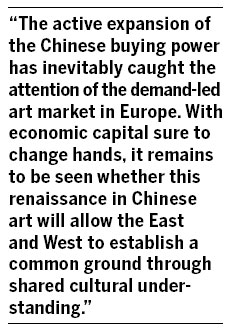


All of these seem to be sending mixed signals to Chinese buyers. On one level they recognize the rise in interest in Chinese antiquities and an increase in the wealth of Chinese collectors. However, they continue to use more familiar territories such as Hong Kong as a conduit to the mainland.
The Chinese elite are often drawn to Europe by the respect for authenticity and diligence when conducting business. They are drawn to spend some of their newly earned economic capital, in exchange for cultural capital in the form of art. Some of them may even hope to understand the history of their past through the artwork, in the hope that, by understanding the past, they will be able to better appreciate where they are going.
However, it is not only the Chinese who have developed a newfound love for the tradition and innovation demonstrated in many of these works. Their European counterparts continue to demonstrate a strong interest in Chinese historical pieces. The current Victoria and Albert Museum exhibition "Masterpieces of Chinese painting 700-1900" has been received warmly in the UK with many struggling to secure tickets for the show.
Some of the Chinese traditional values illustrated through the paintings are surprisingly similar to the pursuits of the British gentleman. For example the leisure activities in pursuit of happiness during prosperous times is a common theme. The paintings also depict the notion of embracing solitude to move away from materialist temptations. This carries a striking similarity with the moral views held in the Victorian era some 300 years ago.
For many Chinese, the traditional Chinese artworks hold more than just financial value. They embody a set of philosophical, symbolic and historical values that are shared by the nation. It is as if audiences in the East and West have found a common ground, a shared social value through the appreciation of traditional Chinese artists.
The active expansion of the Chinese buying power has inevitably caught the attention of the demand-led art market in Europe. With economic capital sure to change hands, it remains to be seen whether this renaissance in Chinese art will allow the East and West to establish a common ground through shared cultural understanding.
The author is director of Singing Grass Communications, an agency bridging the East and the West through arts and culture.